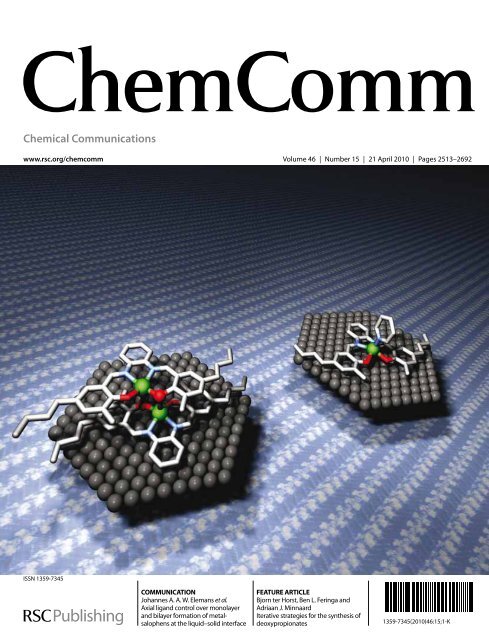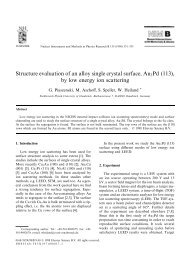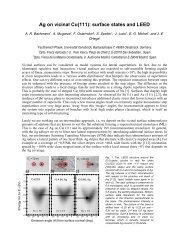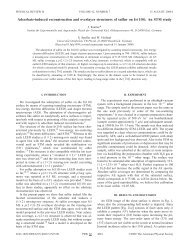Axial ligand control over monolayer and bilayer formation of metal ...
Axial ligand control over monolayer and bilayer formation of metal ...
Axial ligand control over monolayer and bilayer formation of metal ...
You also want an ePaper? Increase the reach of your titles
YUMPU automatically turns print PDFs into web optimized ePapers that Google loves.
Chemical Communications<br />
www.rsc.org/chemcomm Volume 46 | Number 15 | 21 April 2010 | Pages 2513–2692<br />
ISSN 1359-7345<br />
COMMUNICATION<br />
Johannes A. A. W. Elemans et al.<br />
<strong>Axial</strong> <strong>lig<strong>and</strong></strong> <strong>control</strong> <strong>over</strong> <strong>monolayer</strong><br />
<strong>and</strong> <strong>bilayer</strong> <strong>formation</strong> <strong>of</strong> <strong>metal</strong>salophens<br />
at the liquid–solid interface<br />
FEATURE ARTICLE<br />
Bjorn ter Horst, Ben L. Feringa <strong>and</strong><br />
Adriaan J. Minnaard<br />
Iterative strategies for the synthesis <strong>of</strong><br />
deoxypropionates<br />
1359-7345(2010)46:15;1-K
COMMUNICATION www.rsc.org/chemcomm | ChemComm<br />
<strong>Axial</strong> <strong>lig<strong>and</strong></strong> <strong>control</strong> <strong>over</strong> <strong>monolayer</strong> <strong>and</strong> <strong>bilayer</strong> <strong>formation</strong><br />
<strong>of</strong> <strong>metal</strong>-salophens at the liquid–solid interfacewz<br />
Johannes A. A. W. Elemans,* a S<strong>and</strong>er J. Wezenberg, b Michiel J. J. Coenen, c<br />
Eduardo C. Escudero-Adán, b Jordi Benet-Buchholz, b Duncan den Boer, c Sylvia Speller, c<br />
Arjan W. Kleij* bd <strong>and</strong> Steven De Feyter* a<br />
Received (in Cambridge, UK) 23rd October 2009, Accepted 7th January 2010<br />
First published as an Advance Article on the web 25th January 2010<br />
DOI: 10.1039/b922212j<br />
Nickel salophens exclusively form <strong>monolayer</strong>s at a liquid–solid<br />
interface, while in contrast zinc salophens mainly self-assemble<br />
into <strong>bilayer</strong>s via axial <strong>lig<strong>and</strong></strong> self-coordination which can be<br />
disrupted by the addition <strong>of</strong> pyridine axial <strong>lig<strong>and</strong></strong>s.<br />
One <strong>of</strong> the most exciting topics nowadays in scanning<br />
tunneling microscopy (STM) research is the imaging <strong>of</strong><br />
dynamic processes, such as host–guest complexation 1 <strong>and</strong><br />
reactivity 2 <strong>of</strong> functional molecules self-assembled at a<br />
liquid–solid interface. In particular <strong>metal</strong>-porphyrins represent<br />
versatile platforms for the single molecule imaging<br />
<strong>of</strong> axial <strong>lig<strong>and</strong></strong> coordination 3 <strong>and</strong> catalytic processes 4 at<br />
their reactive <strong>metal</strong> centre. Also <strong>metal</strong>-salophens are<br />
interesting molecules for such studies since their flat structure<br />
is ideal for adsorption at a surface. Their rich coordination<br />
behaviour 5 <strong>and</strong> the wealth <strong>of</strong> reactions they can catalyse, 6<br />
depending on the <strong>metal</strong> centre, make them promising<br />
c<strong>and</strong>idates to reveal their structure <strong>and</strong> function at the single<br />
molecule level with STM. It is therefore surprising that so<br />
far only a limited number <strong>of</strong> STM studies have been reported<br />
on <strong>metal</strong>-salen complexes. 7 Here we present our investigations<br />
on the <strong>metal</strong>losupramolecular behaviour <strong>and</strong> function <strong>of</strong><br />
<strong>metal</strong>-salophens Ni1 <strong>and</strong> Zn1 at the liquid–solid interface<br />
with STM. 8 Nickel salens have been reported as catalysts<br />
for oxidation reactions, 9 while zinc salens can catalyse<br />
the alkynylation <strong>of</strong> ketones. 10 We will show that Ni1 exclusively<br />
forms <strong>monolayer</strong>s, while Zn1 can dimerise via axial<br />
<strong>lig<strong>and</strong></strong> self-coordination. The latter leads to the <strong>formation</strong> <strong>of</strong><br />
<strong>bilayer</strong>s, <strong>and</strong> this <strong>bilayer</strong> <strong>formation</strong> can be reversed in a<br />
a Department <strong>of</strong> Chemistry, Division <strong>of</strong> Molecular <strong>and</strong> Nano<br />
Materials, <strong>and</strong> INPAC – Institute for Nanoscale Physics <strong>and</strong><br />
Chemistry, Katholieke Universiteit Leuven, Celestijnenlaan 200-F,<br />
3001 Leuven, Belgium. E-mail: J.Elemans@science.ru.nl,<br />
steven.defeyter@chem.kuleuven.be<br />
b Institute <strong>of</strong> Chemical Research <strong>of</strong> Catalonia (ICIQ),<br />
Av. Paı¨sos Catalans 16, 43007 Tarragona, Spain.<br />
E-mail: akleij@iciq.es<br />
c Institute for Molecules <strong>and</strong> Materials, Radboud University Nijmegen,<br />
Heyendaalseweg 135, 6525 AJ Nijmegen, The Netherl<strong>and</strong>s<br />
d Institucio´ Catalana de Recerca i Estudis Avançats (ICREA),<br />
Pg. Lluı´s Companys 23, 08010 Barcelona, Spain<br />
w Dedicated to Roel<strong>and</strong> J. M. Nolte <strong>and</strong> Javier de Mendoza on the<br />
occasion <strong>of</strong> their 65th birthdays.<br />
z Electronic supplementary in<strong>formation</strong> (ESI) available: Synthetic<br />
details for Zn1 <strong>and</strong> Ni1, STM procedures, magnifications <strong>of</strong> STM<br />
images <strong>and</strong> computer-modeled structures <strong>of</strong> the <strong>monolayer</strong>s, statistics,<br />
additional crystallographic details, NMR <strong>and</strong> UV-vis titration data.<br />
CCDC 748345 for Zn1 Pyr. For ESI <strong>and</strong> crystallographic data in CIF<br />
or other electronic format see DOI: 10.1039/b922212j<br />
<strong>control</strong>led fashion by the addition <strong>of</strong> external axial pyridine<br />
<strong>lig<strong>and</strong></strong>s.<br />
Immediately after depositing a droplet <strong>of</strong> a 1 mM solution<br />
<strong>of</strong> Ni1 or Zn1 in 1-phenyloctane onto a piece <strong>of</strong> freshly cleaved<br />
highly oriented pyrolytic graphite (HOPG), extended twodimensional<br />
layers <strong>of</strong> lamellar arrays <strong>of</strong> these compounds<br />
were observed by STM. The lamellar periodicity is<br />
2.4 0.1 nm, <strong>and</strong> in individual lamellae <strong>of</strong> Ni1 the molecules<br />
are generally arranged in a head-to-tail geometry at a distance<br />
<strong>of</strong> 1.2 nm, with the 1,2-diiminobenzene moieties located in the<br />
centre (Fig. 1 <strong>and</strong> ESIw)). Rather frequently, within the<br />
lamellae defects are present where the orientation direction<br />
<strong>of</strong> the salophen cores is switched 180 degrees, with a tail-to-tail<br />
dimer <strong>of</strong> Ni1 as the switching point (see Fig. 1a). The head-totail<br />
arrangement <strong>of</strong> molecules <strong>of</strong> Ni1 in adjacent lamellae is<br />
either aligned, or oppositely directed (ESIw). Due to this<br />
r<strong>and</strong>omness no general unit cell could be assigned. Within a<br />
single domain the alkyl chains <strong>of</strong> Ni1 are all interdigitated <strong>and</strong><br />
directed along one <strong>of</strong> the main symmetry axes <strong>of</strong> graphite,<br />
irrespective <strong>of</strong> the orientation direction <strong>of</strong> the salophen cores.<br />
The self-assembly behaviour <strong>of</strong> Zn1 at the same liquid–solid<br />
interface is strikingly different from that <strong>of</strong> Ni1. Instead<br />
<strong>of</strong> homogeneous domains <strong>of</strong> well-resolved molecules, the<br />
majority <strong>of</strong> the surface was c<strong>over</strong>ed with less ordered <strong>and</strong> less<br />
Fig. 1 (a) STM topography <strong>of</strong> a <strong>monolayer</strong> <strong>of</strong> Ni1 at the graphite/<br />
1-phenyloctane interface; Vbias = 680 mV, Iset = 417 pA; the dashed<br />
white rectangles indicate a switch <strong>of</strong> orientation <strong>of</strong> the molecules <strong>of</strong><br />
Ni1 within a lamellar array. (b) Zoom with some schematic Ni1<br />
molecules superimposed to indicate their orientation.<br />
2548 | Chem. Commun., 2010, 46, 2548–2550 This journal is c The Royal Society <strong>of</strong> Chemistry 2010
well-resolved lamellar arrays, with a periodicity <strong>of</strong> 2.3 0.1 nm,<br />
as observed by STM (Fig. 2a <strong>and</strong> ESIw). We conclude there is<br />
a <strong>bilayer</strong> stacking <strong>of</strong> Zn1 molecules, composed <strong>of</strong> doublestr<strong>and</strong>ed<br />
lamellae <strong>of</strong> c<strong>of</strong>acially stacked <strong>metal</strong>-salophen units.<br />
In these complex structures the alkyl chains are no longer<br />
resolved. In the cross section, three distinct height levels can be<br />
discriminated (Fig. 2b). The height differences in between<br />
them measure B0.25 nm. We propose that the observed<br />
heights correspond to locations in the layer where a <strong>bilayer</strong><br />
structure <strong>of</strong> dimeric complexes <strong>of</strong> Zn1 (D), a <strong>monolayer</strong><br />
structure (M), <strong>and</strong> vacancies (V) are present (Fig. 2b <strong>and</strong><br />
ESIw). Inspection <strong>of</strong> many locations on the samples yielded<br />
no indication <strong>of</strong> higher order multilayers, suggesting that the<br />
self-assembly stops at the level <strong>of</strong> a dimer. 11<br />
The ability <strong>of</strong> zinc salophen complexes such as Zn1 to form<br />
dimeric assemblies in the solid state via m 2-O bridging has been<br />
previously investigated by X-ray diffraction. 12 In the case <strong>of</strong><br />
Zn1, such an axial <strong>lig<strong>and</strong></strong>-directed self-assembly can lead to the<br />
<strong>formation</strong> <strong>of</strong> stable homodimers with a structure as shown in<br />
Fig. 2c. C<strong>of</strong>acial homodimers, in which the two zinc centres<br />
are involved in a four-point interaction <strong>and</strong> one <strong>of</strong> the<br />
phenolic oxygen atoms <strong>of</strong> each molecule bridges in an<br />
axial-<strong>lig<strong>and</strong></strong> fashion to its dimeric partner molecule, are<br />
believed to give a highly stable assembled state.<br />
Fig. 2 (a) STM topography <strong>of</strong> a self-assembled layer <strong>of</strong> Zn1 at the<br />
interface <strong>of</strong> graphite <strong>and</strong> 1-phenyloctane; Vbias = 680 mV, Iset =<br />
205 pA; locations <strong>of</strong> a dimeric structure (D), a monomeric structure<br />
(M), <strong>and</strong> a vacancy (V) are indicated. (b) Cross section corresponding<br />
to the dashed white trace in (a). (c) Computer-modelled dimer <strong>of</strong> Zn1<br />
(side <strong>and</strong> top view), based on the STM <strong>and</strong> NMR dilution studies,<br />
showing the proposed four-point coordinative interaction (alkyl<br />
chains have been omitted). (d) STM topography image <strong>of</strong> <strong>monolayer</strong><br />
domains <strong>of</strong> Zn1. (e) Zoom with the unit cell depicted; a =(1.2 0.1) nm,<br />
b = (4.1 0.2) nm, a = (86 2)1; some schematic molecules <strong>of</strong> Zn1<br />
are drawn in.<br />
The assembly <strong>formation</strong> <strong>of</strong> Zn1 was further examined in<br />
solution by 1 H NMR dilution experiments. In CDCl3, no<br />
observable changes in the proton signals were noted in the<br />
concentration range 10 3 –10 4 M. However, the addition <strong>of</strong><br />
5% <strong>of</strong> CD 3OD to a 10 3 M solution resulted in significant<br />
downfield shifts (0.1–0.3 ppm) <strong>of</strong> all aromatic <strong>and</strong> imine<br />
proton signals <strong>of</strong> the compound, as well as the signals <strong>of</strong> the<br />
aryl-CH3 groups <strong>and</strong> the first methylene group <strong>of</strong> the alkyl<br />
chains. In contrast, the proton signals <strong>of</strong> Ni1 in CDCl3<br />
appeared to be insensitive to the addition <strong>of</strong> CD3OD (ESIw).<br />
The NMR results are in line with the breaking up <strong>of</strong> dimeric<br />
into monomeric Zn1 species as a result <strong>of</strong> the competitive axial<br />
coordination <strong>of</strong> CD3OD to Zn1. Various examples <strong>of</strong> zinc<br />
salen derivatives to which nitrogen- or oxygen-donor <strong>lig<strong>and</strong></strong>s<br />
are axially coordinated have been reported. 12b,13 The basis for<br />
the strong binding <strong>of</strong> these donor <strong>lig<strong>and</strong></strong>s is the high Lewis<br />
acidity <strong>of</strong> the zinc ion, which is dictated by the rigid geometry<br />
enforced by the salophen <strong>lig<strong>and</strong></strong>. 14<br />
To quantify the dimerisation <strong>of</strong> Zn1 in solution, UV-vis<br />
dilution measurements in toluene were carried out at concentrations<br />
as low as 10 6 M. No changes were noted in the<br />
UV-vis spectrum between 10 4 to 10 6 M, indicative <strong>of</strong> a<br />
strong association process. Since no direct measurement <strong>of</strong><br />
Kdimer could be accomplished, the self-assembly behaviour <strong>of</strong><br />
two different but electronically similar zinc salophen model<br />
complexes Zn2 <strong>and</strong> Zn3 (ESIw) was investigated. These<br />
complexes only differ in the position <strong>of</strong> the two pendent t Bu<br />
groups. The presence <strong>of</strong> two t Bu groups in the 3-position<br />
<strong>of</strong> the salophen <strong>lig<strong>and</strong></strong> (Zn2) effectively supresses dimer<br />
<strong>formation</strong>, 12b,15 while for Zn3 a dimeric species is expected<br />
to prevail in solution. From these titration studies the Kdimer<br />
for Zn3 was estimated to be 3.2 0.01 10 8 M 1 . This very<br />
high association constant for the dimer species further<br />
supports the observation <strong>of</strong> <strong>bilayer</strong>s <strong>of</strong> Zn1 by STM.<br />
Although the majority <strong>of</strong> the surface (>90%) was c<strong>over</strong>ed<br />
with a layer <strong>of</strong> predominantly dimeric species, occasionally<br />
very small domains containing exclusively well-resolved<br />
monomeric structures <strong>of</strong> Zn1 were found (Fig. 2d–e). These<br />
domains were very unstable <strong>and</strong> typically disappeared within a<br />
couple <strong>of</strong> minutes. Lowering the concentration <strong>of</strong> Zn1 in the<br />
subphase to 0.2 mM did not lead to large variations in the<br />
population between the <strong>monolayer</strong> <strong>and</strong> <strong>bilayer</strong> domains. In<br />
comparison with the <strong>monolayer</strong> <strong>of</strong> Ni1, the <strong>monolayer</strong>s <strong>of</strong> Zn1<br />
are more homogenic in the sense that hardly any defects were<br />
found <strong>and</strong> the direction <strong>of</strong> the head-to-tail orientation <strong>of</strong> the<br />
molecules alternated with high regularity between adjacent<br />
lamellae. Remarkably, in contrast to <strong>monolayer</strong>s <strong>of</strong> Ni1, the<br />
alkyl chains between the lamellae <strong>of</strong> Zn1 are, while being<br />
interdigitated, organized in a zig-zag geometry, thereby still<br />
following two <strong>of</strong> the underlying graphite main symmetry<br />
axes. The lamellar periodicity is somewhat smaller, viz.<br />
2.2 0.1 nm.<br />
The high regularity <strong>and</strong> in particular the complete absence<br />
<strong>of</strong> dimeric structures in the <strong>monolayer</strong> domains is in sharp<br />
contrast with the domains where the dimeric complexes<br />
prevail. It suggests that the <strong>formation</strong> <strong>of</strong> the second layer is<br />
a cooperative process, which is reflected in the complete<br />
absence, all <strong>over</strong> the sample, <strong>of</strong> single dimeric complexes or<br />
even small domains <strong>of</strong> them.<br />
This journal is c The Royal Society <strong>of</strong> Chemistry 2010 Chem. Commun., 2010, 46, 2548–2550 | 2549
Fig. 3 (a) STM image <strong>of</strong> the interface between graphite <strong>and</strong> a<br />
solution <strong>of</strong> Zn1 (1 mM) <strong>and</strong> pyridine (10 mM) in 1-phenyloctane.<br />
V bias = 680 mV, I set = 221 pA. (b) Magnification showing the unit<br />
cell; a = (1.1 0.1) nm, b = (4.3 0.2) nm, a = (88 2)1; some<br />
schematic salens are drawn in. (c) X-ray structure <strong>of</strong> the complex<br />
between Zn1 <strong>and</strong> pyridine.<br />
Since zinc salens form strong complexes with N-donor axial<br />
<strong>lig<strong>and</strong></strong>s, 13 it was reasoned that the complexation <strong>of</strong> such a<br />
<strong>lig<strong>and</strong></strong> to Zn1 would inhibit dimerisation <strong>and</strong> possibly result in<br />
the <strong>formation</strong> <strong>of</strong> discrete 1 : 1 salophen-<strong>lig<strong>and</strong></strong> complexes at the<br />
liquid–solid interface. Zn1 was found to form a strong<br />
complex with pyridine <strong>and</strong> the X-ray structure <strong>of</strong> the 1 : 1<br />
complex was solved, which is depicted in Fig. 3c. Indeed, when<br />
a solution <strong>of</strong> Zn1 <strong>and</strong> 10 equiv. <strong>of</strong> pyridine in 1-phenyloctane<br />
was brought onto a graphite surface, STM revealed the<br />
complete absence <strong>of</strong> the <strong>bilayer</strong>-like features <strong>and</strong> <strong>over</strong> the<br />
entire sample homogeneous domains <strong>of</strong> lamellar arrays with<br />
high internal resolution <strong>and</strong> a periodicity <strong>of</strong> 2.3 0.1 nm are<br />
observed (Fig. 3a–b). As found in the case <strong>of</strong> the <strong>monolayer</strong>s<br />
<strong>of</strong> uncomplexed Zn1, the alkyl chains are interdigitated.<br />
Although the pyridine <strong>lig<strong>and</strong></strong>s could not be directly imaged,<br />
it is obvious that they must play a crucial role in the<br />
adsorption behaviour <strong>of</strong> Zn1 at the liquid–solid interface.<br />
The successful competition <strong>of</strong> the pyridine <strong>lig<strong>and</strong></strong> with a<br />
second molecule <strong>of</strong> Zn1 for coordination at the zinc <strong>metal</strong> in<br />
solution is directly translated to the self-assembly <strong>of</strong> Zn1 in a<br />
layer <strong>of</strong> monomers at the surface.<br />
In summary, we have shown that <strong>metal</strong>-salophens with a<br />
high structural similarity can be imaged with high resolution in<br />
STM. The molecules self-assemble in strikingly different<br />
architectures at the liquid–solid interface, as a result <strong>of</strong> axial<br />
<strong>lig<strong>and</strong></strong> effects. The elucidation <strong>of</strong> such structural behaviour at<br />
the single molecule level with STM can be <strong>of</strong> great importance<br />
for the reactivity <strong>of</strong> catalytic surfaces. In particular, it can be<br />
expected that different molecular organisations will give rise to<br />
differences in reactivity. Future work will be therefore directed<br />
to investigate the relationship between structure <strong>and</strong> reactivity<br />
<strong>of</strong> <strong>metal</strong>-salophens at the liquid–solid interface, studied in situ<br />
by STM.<br />
The Fund <strong>of</strong> Scientific Research–Fl<strong>and</strong>ers (FWO),<br />
K. U. Leuven (GOA 2006/2), the Belgian Federal Science<br />
Policy Office (IAP-6/2), ICIQ, ICREA, the Spanish Ministry<br />
<strong>of</strong> Science <strong>and</strong> Innovation (MICINN, project CTQ2008-<br />
02050/BQU) <strong>and</strong> Consolider Ingenio 2010 (grant CSD2006-<br />
0003), <strong>and</strong> NanoNed – the Dutch nanotechnology initiative by<br />
the Ministry <strong>of</strong> Economic Affairs, are acknowledged for<br />
financial support.<br />
Notes <strong>and</strong> references<br />
1(a) T. Kudernac, S. Lei, J. A. A. W. Elemans <strong>and</strong> S. De Feyter,<br />
Chem. Soc. Rev., 2009, 38, 402; (b) S. Stepanow, M. Lingenfelder,<br />
A. Dmitriev, H. Spillmann, E. Delvigne, N. Lin, X. Deng, C. Cai,<br />
J. V. Barth <strong>and</strong> K. Kern, Nat. Mater., 2004, 3, 229; (c) G. Schull,<br />
L. Douillard, C. Fiorini-Debuisschert, F. Charra, F. Mathevet,<br />
D. Kreher <strong>and</strong> A. J. Attias, Nano Lett., 2006, 6, 1360; (d) S.J.H.<br />
Griessl, M. Lackinger, F. Jamitzky, T. Markert, M. Hietschold<br />
<strong>and</strong> W. M. Heckl, J. Phys. Chem. B, 2004, 108, 11556;<br />
(e) N. Wintjes, D. Bonifazi, F. Cheng, A. Kiebele, M. Sto¨hr,<br />
T. Jung, H. Spillmann <strong>and</strong> F. Diederich, Angew. Chem., Int. Ed.,<br />
2007, 46, 4089; (f) J. Adisoejoso, K. Tahara, S. Okuhata, S. Lei,<br />
Y. Tobe <strong>and</strong> S. De Feyter, Angew. Chem., Int. Ed., 2009, 48, 7353.<br />
2(a) L. Piot, D. Bonifazi <strong>and</strong> P. Samorí, Adv. Funct. Mater., 2007,<br />
17, 3689; (b) J. A. A. W. Elemans, S. Lei <strong>and</strong> S. De Feyter, Angew.<br />
Chem., Int. Ed., 2009, 48, 7298; (c) J. A. A. W. Elemans, Mater.<br />
Today, 2009, 12, 34.<br />
3(a) J. Visser, N. Katsonis, J. Vicario <strong>and</strong> B. L. Feringa, Langmuir,<br />
2009, 25, 5980; (b) M. C. Lensen, J. A. A. W. Elemans, S. J. T. van<br />
Dingenen, J. W. Gerritsen, S. Speller, A. E. Rowan <strong>and</strong><br />
R. J. M. Nolte, Chem.–Eur. J., 2007, 13, 7948.<br />
4 B. Hulsken, R. van Hameren, J. W. Gerritsen, T. Khoury,<br />
P. Thordarson, M. J. Crossley, A. E. Rowan, R. J. M. Nolte,<br />
J. A. A. W. Elemans <strong>and</strong> S. Speller, Nat. Nanotechnol., 2007, 2,<br />
285.<br />
5(a) P. G. Cozzi, Chem. Soc. Rev., 2004, 33, 410; (b) A. C. W. Leung<br />
<strong>and</strong> M. J. MacLachlan, J. Inorg. Organomet. Polym. Mater., 2007,<br />
17, 57; (c) S. J. Wezenberg <strong>and</strong> A. W. Kleij, Angew. Chem., Int. Ed.,<br />
2008, 47, 2354; (d) A. W. Kleij, Chem.–Eur. J., 2008, 14, 10520;<br />
(e) D. A. Atwood <strong>and</strong> M. J. Harvey, Chem. Rev., 2001, 101, 37.<br />
6(a) K. Matsumoto, B. Saito <strong>and</strong> T. Katsuki, Chem. Commun.,<br />
2007, 3619; (b) E. N. Jacobsen, Acc. Chem. Res., 2000, 33, 421;<br />
(c) E. M. McGarrigle <strong>and</strong> D. G. Gilheany, Chem. Rev., 2005, 105,<br />
1563; (d) C. Baleizão <strong>and</strong> H. Garcia, Chem. Rev., 2006, 106, 3987;<br />
(e) D. J. Darensbourg, Chem. Rev., 2007, 107, 2388.<br />
7(a)M.T.Räisa¨nen, F. Mo¨gele, S. Feodorow, B. Rieger, U. Ziener,<br />
M. Leskelä <strong>and</strong> T. Repo, Eur. J. Inorg. Chem., 2007, 4028;<br />
(b) S. Kuck, S.-H. Chang, J.-P. Klo¨ckner, M. H. Prosenc,<br />
G. H<strong>of</strong>fmann <strong>and</strong> R. Wiesendanger, ChemPhysChem, 2009, 10,<br />
2008.<br />
8 For a review on STM <strong>of</strong> <strong>metal</strong>losupramolecular systems see:<br />
S.-S. Li, B. H. Northrop, Q.-H. Yuan, L.-J. Wan <strong>and</strong><br />
P. J. Stang, Acc. Chem. Res., 2009, 42, 249.<br />
9 R. Ferreira, H. Garcia, B. de Castro <strong>and</strong> C. Freire, Eur. J. Inorg.<br />
Chem., 2005, 4272.<br />
10 P. G. Cozzi, Angew. Chem., Int. Ed., 2003, 42, 2895.<br />
11 Some other examples <strong>of</strong> multilayered structures visualised by<br />
STM: (a) L. Piot, C. Marie, X. Feng, K. Mu¨llen <strong>and</strong> D. Fichou,<br />
Adv. Mater., 2008, 20, 3854; (b) S. Lei, J. Puigmarti-Luis,<br />
A. Minoia, M. Van der Auweraer, C. Rovira, R. Lazzaroni,<br />
D. B. Amabilino <strong>and</strong> S. De Feyter, Chem. Commun., 2008, 703.<br />
12 (a) J. Reglinski, S. Morris <strong>and</strong> D. Stevenson, Polyhedron, 2002, 21,<br />
2175; (b) A. W. Kleij, M. Kuil, M. Lutz, D. M. Tooke, A. L. Spek,<br />
P. C. J. Kamer, P. W. N. M. van Leeuwen <strong>and</strong> J. N. H. Reek,<br />
Inorg. Chim. Acta, 2006, 359, 1807.<br />
13 (a) E. C. Escudero-Ada´n, J. Benet-Buchholz <strong>and</strong> A. W. Kleij, Eur.<br />
J. Inorg. Chem., 2009, 3562; (b) E. C. Escudero-Ada´n, J. Benet-<br />
Buchholz <strong>and</strong> A. W. Kleij, Inorg. Chem., 2008, 47, 4256;<br />
(c) E. C. Escudero-Ada´n, J. Benet-Buchholz <strong>and</strong> A. W. Kleij,<br />
Inorg. Chem., 2008, 47, 410.<br />
14 A. W. Kleij, D. M. Tooke, M. Kuil, M. Lutz, A. L. Spek <strong>and</strong><br />
J. N. H. Reek, Chem.–Eur. J., 2005, 11, 4743.<br />
15 A. L. Singer <strong>and</strong> D. A. Atwood, Inorg. Chim. Acta, 1998, 277, 157.<br />
2550 | Chem. Commun., 2010, 46, 2548–2550 This journal is c The Royal Society <strong>of</strong> Chemistry 2010





